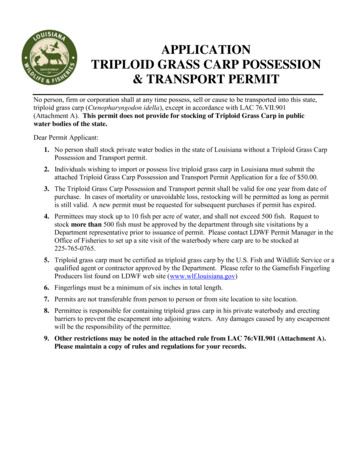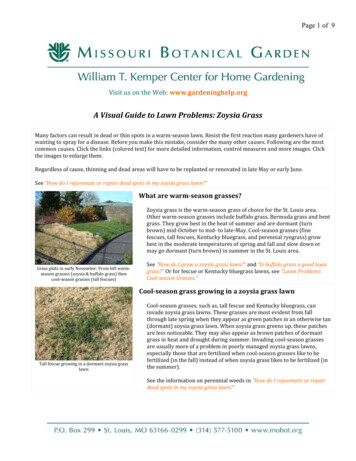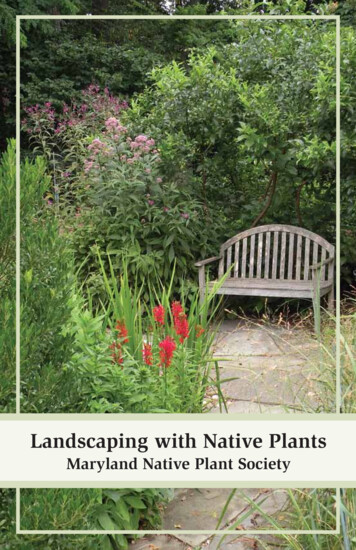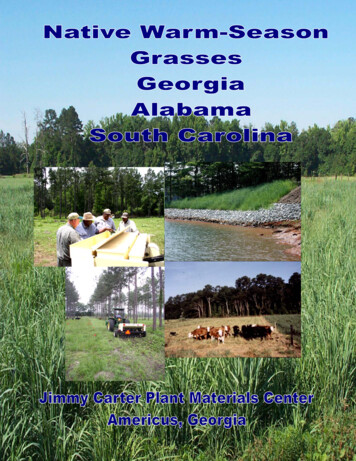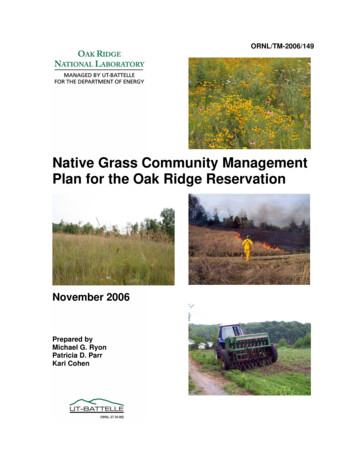
Transcription
ORNL/TM-2006/149Native Grass Community ManagementPlan for the Oak Ridge ReservationNovember 2006Prepared byMichael G. RyonPatricia D. ParrKari Cohen
DOCUMENT AVAILABILITYReports produced after January 1, 1996, are generally available free via the U.S. Department ofEnergy (DOE) Information Bridge.Web site http://www.osti.gov/bridgeReports produced before January 1, 1996, may be purchased by members of the public from thefollowing source.National Technical Information Service5285 Port Royal RoadSpringfield, VA 22161Telephone 703-605-6000 (1-800-553-6847)TDD 703-487-4639Fax 703-605-6900E-mail info@ntis.govWeb site ts are available to DOE employees, DOE contractors, Energy Technology Data Exchange(ETDE) representatives, and International Nuclear Information System (INIS) representatives fromthe following source.Office of Scientific and Technical InformationP.O. Box 62Oak Ridge, TN 37831Telephone 865-576-8401Fax 865-576-5728E-mail reports@osti.govWeb site http://www.osti.gov/contact.htmlThis report was prepared as an account of work sponsored by anagency of the United States Government. Neither the United StatesGovernment nor any agency thereof, nor any of their employees,makes any warranty, express or implied, or assumes any legal liabilityor responsibility for the accuracy, completeness, or usefulness of anyinformation, apparatus, product, or process disclosed, or representsthat its use would not infringe privately owned rights. Referenceherein to any specific commercial product, process, or service bytrade name, trademark, manufacturer, or otherwise, does notnecessarily constitute or imply its endorsement, recommendation, orfavoring by the United States Government or any agency thereof. Theviews and opinions of authors expressed herein do not necessarilystate or reflect those of the United States Government or any agencythereof.
ORNL/TM-2006/149NATIVE GRASS COMMUNITY MANAGEMENT PLANFOR THE OAK RIDGE RESERVATIONMichael G. RyonEnvironmental Sciences DivisionPatricia Dreyer ParrFacilities and Operations DirectorateKari CohenNatural Resources Conservation Service,United States Department of AgricultureNovember 2006Prepared byOAK RIDGE NATIONAL LABORATORYP.O. Box 2008Oak Ridge, Tennessee 37831-6283managed byUT-BATTELLE, LLCfor theU.S. DEPARTMENT OF ENERGYunder contract DE-AC05-00OR2272
CONTENTSPageLIST OF FIGURES. vLIST OF TABLES . viiACRONYMS . ixEXECUTIVE SUMMARY . xi1. INTRODUCTION. 11.1 OAK RIDGE RESERVATION . 11.2 NATIVE WARM-SEASON GRASSES. 11.3 PLANTING NATIVE GRASSES ON THE ORR. 42. BENEFITS OF PLANTING NATIVE GRASSES . 52.1 COMPLIANCE WITH FEDERAL GUIDANCE. 52.2 BENEFITS TO WILDLIFE. 52.3 RESTORATION OF NATIVE PLANT AND WILDLIFE COMMUNITIES. 62.4 ADDITIONAL BENEFICIAL CHARACTERISTICS OF NATIVE GRASSES. 72.5 ECONOMIC BENEFITS OF PLANTING NATIVE GRASSES . 72.6 GUIDELINES TO PLANTING AND MAINTAINING NATIVE WARM-SEASONGRASSES ON THE ORR . 73. NATIVE GRASS SITE SELECTION STRATEGY FOR THE ORR. 83.1 ROAD RIGHTS-OF-WAY. 83.2 UTILITY RIGHTS-OF-WAY . 83.3 FALLOW HAY OR FORAGE FIELDS OF NONNATIVE GRASSES . 93.4 REMEDIATION SITES . 93.5 FACILITY BUFFER ZONES. 93.6 OTHER POTENTIAL SITES. 103.6.1 Pine Salvage Areas. 103.6.2 Construction Areas. 103.6.3 Invasive Plant Treatment Areas . 104. AGENCY INTERACTIONS AND COMMUNITY OUTREACH . 115. MANAGEMENT GOALS AND ACHIEVEMENTS, FISCAL YEARS 2002–2005 . 115.1 GOALS, FISCAL YEARS 2002–2005. 115.2 ACHIEVEMENTS, FISCAL YEARS 2002–2005. 125.3 LESSONS LEARNED, FISCAL YEARS 2003–2005 . 136. MANAGEMENT GOALS AND ACHIEVEMENTS, FISCAL YEARS 2006 AND 2007. 146.1 BETHEL VALLEY ROAD . 146.2 FIRST CREEK RIPARIAN ZONE . 146.3 BEAR CREEK WEIR RIPARIAN ZONE . 146.4 ORNL POWER-LINE RIGHTS-OF-WAY. 156.5 BIOSLUDGE APPLICATION FIELDS . 156.6 TREATED KUDZU PATCHES. 156.7 PRESCRIBED BURNS . 157. REFERENCES. 15APPENDIX A. PLANTING GUIDE FOR NATIVE WARM-SEASON GRASSES . A-1APPENDIX B. MAINTENANCE OF NATIVE WARM-SEASON GRASSLANDS. B-1iii
LIST OF FIGURESFigure123456PageBig bluestem (Andropogon gerardii) in cedar barren habitat. . 2Indian grass (Sorghastrum nutans) showing seed heads. . 2Switch grass (Pancium virgatum) showing seed heads. 3Little bluestem (Schizachyrium scoparium) along power line right-of-way. . 3Warm-season grassland with open spaces between bunches of grasses. 6Locations of primary native warm-season grass restoration sites on the ORR. . 13v
LIST OF TABLESTable1PageNative warm-season grassland project summary, fiscal years 2002–2005 . 12vii
ACRONYMSDOEESDF&OFYGSMNPORNLORRTVATWRADepartment of EnergyEnvironmental Sciences DivisionFacilities and Operations (Directorate)fiscal yearGreat Smoky Mountains National ParkOak Ridge National LaboratoryOak Ridge ReservationTennessee Valley AuthorityTennessee Wildlife Resources Agencyix
EXECUTIVE SUMMARYLand managers at the Department of Energy’s Oak Ridge National Laboratory in East Tennesseeare restoring native warm-season grasses and wildflowers to various sites across the Oak RidgeReservation (ORR). Some of the numerous benefits to planting native grasses and forbs includeimproved habitat quality for wildlife, improved aesthetic values, lower long-term maintenance costs,and compliance with Executive Order 13112 (Clinton 1999). Challenges to restoring native plants onthe ORR include the need to gain experience in establishing and maintaining these communities andthe potentially greater up-front costs of getting native grasses established. The goals of the nativegrass program are generally outlined on a fiscal-year basis. An overview of some of the issuesassociated with the successful and cost-effective establishment and maintenance of native grass andwildflower stands on the ORR is presented in this report.xi
1. INTRODUCTIONThe Oak Ridge Reservation (ORR) is currently managed so as to promote a diversity of nativeplant communities, protect the value of the land and its resources, provide a buffer for the federalfacilities located within its borders, and provide a site for research on environmental issues. As part ofthis management strategy, the value of native plants is highlighted, including native warm-seasongrasses. This document outlines the management strategy and role of native warm-season grasses aspart of the overall management approach for the ORR as a federal area (e.g., Clinton 1999).1.1OAK RIDGE RESERVATIONThe Department of Energy (DOE) ORR lies in the Valley and Ridge Physiographic Province,located between the Cumberland Plateau and the Smoky Mountains. It consists of 33,722 acres(13,647 ha) in Anderson and Roane Counties in East Tennessee. The land was originally purchased in1942 by the federal government to be used for the Manhattan Project. Three parcels of land weredeveloped for that purpose, while the remaining forest was left intact for security purposes. Despitesome logging and further development in the intervening years, much of the ORR remains contiguousnative forest (Mann et al. 1996), and compared with development elsewhere in the physiographicprovince, the ORR is a critical island of undisturbed land.The Oak Ridge National Environmental Research Park, established by DOE in 1989, currentlyprovides about 20,000 acres (8,094 ha) for research and education. The park was designated aninternational biosphere reserve in 1989 and is also a unit member of the Southern AppalachianBiosphere Reserve. Currently, the ORR is a wildlife management area and is managed by theTennessee Wildlife Resources Agency (TWRA) (DOE 2005). In 1999, DOE designated 2,920 acres(1,182 ha) of the ORR as the Three Bend Scenic and Wildlife Management Refuge Area, which ismanaged by TWRA through an agreement with DOE. In 2005, 3,000 acres (1,214 ha) were protectedthrough a conservation easement between DOE and the state of Tennessee. This Black Oak RidgeConservation Easement Area borders the northern edge of the ORR along Poplar Creek and ismanaged by TWRA.Within the ORR the richness of vascular plants rivals that of the Great Smoky MountainsNational Park (GSMNP) in the eastern United States. For example, in 1996 more than 1,100 vascularplant species were documented on the ORR, compared to approximately 1,650 for the GSMNP(Mann et al. 1996). Twenty-one of these are state-listed rare plants. The ORR has about four times asmany listed species per unit area as the GSMNP—an impressive return in species per investment inarea (Mann and Parr 1995). Animal life is also abundant on the ORR, with more than 315 wildlifespecies, including at least 20 state- or federal-listed rare animal species (Mitchell et al. 1996).1.2NATIVE WARM-SEASON GRASSESNative grasses typically used in planting and restoration efforts are native warm-season grasses,otherwise known as prairie or bunch grasses. These grasses grow in deep-rooted clumps and can growup to 8 ft (2.4 m) tall. Native warm-season grasses bloom from June through September and completetheir growth cycle in late summer or fall. In contrast, cool-season grasses such as tall fescue generallybloom in early spring, go dormant and do not grow vigorously during the summer, and then revive astemperatures cool in the fall. Many cool-season grass species are native to Europe and Asia and areadapted to the climates of those locations (Shea 1999).Approximately 50 genera of native grasses are found in East Tennessee (Shea 1999). Of these themost common warm-season grasses used in planting and restoration efforts are big bluestem(Andropogon gerardii, Fig. 1), Indian grass (Sorghastrum nutans, Fig. 2), switch grass (Panicumvirgatum, Fig. 3), eastern gamma grass (Tripsacum dactyloides), little bluestem (Schizachyrium1
Fig. 1. Big bluestem (Andropogon gerardii) in cedar barren habitat.Fig. 2. Indian grass (Sorghastrum nutans) showing seed heads.2
Fig. 3. Switch grass (Pancium virgatum) showing seed heads.scoparium, Fig. 4), and sideoats grama (Bouteloua curtipendula). The first four species in this list are“tall” grasses, ranging from approximately 3 to 8 ft (1 to 2.4 m) in height and are typical componentsof the Tall or Mixed Grass Prairies. Little bluestem and sideoats grama grow from 2 to 4 ft (0.6 to1.2 m) tall and occur in the Short and Mixed Grass Prairies (Brown 1979).Fig. 4. Little bluestem (Schizachyrium scoparium) along power line right-of-way.3
Although most people think of prairies as occurring only in the midwestern United States, smallgrasslands and oak and pine savannahs were an integral part of much of Tennessee when Europeansettlers arrived (Packard and Mutel 1997). Today, few stands of remnant native grasses are found onthe ORR. Most of these stands are found on remnant barrens ecosystems. After the end of the last iceage approximately 10,000 years ago, prairies began to extend into Tennessee (Shea 1999). The typeof prairie found in East Tennessee, “barrens,” is characterized by the presence of native grass andforb (nonwoody herbaceous plants, such as wildflowers and legumes) species interspersed with a fewcedar trees. Cedar barrens are naturally occurring on shallow, flaggy limestone soils and were oncefound throughout the Valley and Ridge Province. The shallow, dry soils prevent most tree speciesfrom becoming established (Mann et al. 1996).A few small cedar barrens persist on the ORR. Raccoon Creek Barren is a representative cedarbarren located near the western border of the ORR. Two others (including one that is home to one ofthe world’s largest population of the Tennessee-listed tall larkspur, Delphinium exaltatum) are locatedadjacent to Bethel Valley Road (Mann and Parr 1995). Many of the cedar barrens that once existed inthe Valley and Ridge Province have been lost or degraded as a result of disturbance suppression,dumping of debris, development, or exotic-species invasion (Mann et al. 1996).The loss of grasslands in Tennessee mirrors a national trend. Today, less than 1% of the historicacreage of grassland ecosystems remains (Frost 2000; Kurtz 2001), and many animal speciesassociated with grasslands (particularly grassland bird species) have shown population declines(Madden et al. 2000; Brennan and Kuvlesky 2005). This large-scale disappearance of grasslandecosystems has sparked nationwide interest in restoring native grasses. Restoring native communitiesand improving the status of grassland wildlife are often the motivations behind replanting efforts.Prairie restoration has been carried out in parts of the Midwest for many decades (Kurtz 2001).Another DOE National Environmental Research Park, Fermilab, outside Chicago, is home to a model,restored prairie more than 1,200 acres (486 ha) in size. Land managers have been planting nativegrasses and wildflowers there for more than 25 years (Lane and BassiriRad 2005).1.3PLANTING NATIVE GRASSES ON THE ORRThe importance of planting native species was recognized by the federal government in the mid1990s. The 1995 Presidential Memorandum on Environmentally and Economically BeneficialLandscape Practices on Federal Landscaped Grounds lists the planting of “regionally native plants” asone of its five guiding principles (EPA 1995). Executive Order 13112, signed in 1999, supports therestoration of native species by federal agencies (Clinton 1999). According to Executive Order 13112,the term “‘native species’ means, with respect to a particular ecosystem, a species that, other than as aresult of an introduction, historically occurred or currently occurs in that ecosystem.” With respect tothis document, a native grass species is one that historically occurred on the ORR prior to humandisturbance and the widespread introduction of nonnative grass species.In Tennessee, there is little cognizance of grassland ecosystems compared to the deciduousforests for which the state is known. As a result, native grass restoration in Tennessee is a relativelynew phenomenon, and one that has so far been largely focused on agricultural areas. There are,however, a number of examples of restoration projects currently under way on federal lands.Resource managers at both the GSMNP and Cherokee National Forest are in the initial stages ofrestoring native grasses on their properties (Beeler 2000). In addition, for a number of years theTennessee Valley Authority (TVA) has worked both on its own lands and with private landowners onnative grass projects.DOE Natural Resource Managers and cooperating agencies and organizations are committed topursuing the planting of native grasses on various parts of the ORR. In almost every case, theserestoration efforts will be designed to create grassland communities that include a mix of nativewarm-season grasses and appropriate native wildflowers and forbs. This document is intended toguide the implementation of a native grass planting and restoration program for the ORR.4
2. BENEFITS OF PLANTING NATIVE GRASSESThe initiative to plant native grasses and forbs has been propelled by the recognition of thebenefits—both economic and environmental—that native species provide but that are not a feature ofnonnative grass species. This section highlights the main benefits to the ORR of planting native grassand wildflower species. Note that the following discussion does not include the benefits that nativegrasses provide to farmers (such as increased forage and soil conservation). This guide is intended, asmuch as possible, to be a practical document regarding the restoration of native grasses on the ORR.2.1COMPLIANCE WITH FEDERAL GUIDANCEAs the issue of exotic, introduced, and invasive species has gained increased attention in recentyears, the White House has promulgated two missives designed to provide federal leadership incontrolling the number and impact of invasive species in Executive Order 13112, Sect. 2 that apply toplanting native grasses on the ORR. Section 2 states that “each federal agency whose actions mayaffect the status of invasive species shall . . . (I) prevent the introduction of invasive species . . . and(IV) provide for the restoration of native species and habitat conditions in ecosystems that have beeninvaded . . .” (Clinton 1999).Guidance for Presidential Memorandum on Environmentally and Economically BeneficialLandscape Practices on Federal Landscaped Grounds (FRL-5275-6) was issued in 1995 and focuseson five guiding principles (EPA 1995). Principle one, “Use Regionally Native Plants forLandscaping,” is the most relevant to this document. It states that native plants should be used tolandscape managed federal lands and federally funded projects “where the appropriate conditionsexist.”The Tennessee Exotic Pest Plant Council has published a list of invasive plants in Tennessee(Tennessee Exotic Pest Plants Council 2004). Restoration goals for the ORR will support removal ofexisting exotic plants (Parr et al. 2004).2.2BENEFITS TO WILDLIFEThe clumped structure of native grass communities (Fig. 5) makes them ideal habitat for wildlifethat depend on grasses for cover, nesting, and food (Byre 1997). The tall upright structure of nativegrasses provides cover for small mammals, which gives some protection from avian predators. Theystand upright under snow and thus continue to provide cover through the winter. The bare groundbetween grass clumps allows animals to move easily through the habitat and provides nesting spacefor grassland songbirds such as grasshopper sparrow (Ammodramus savannarum), bobolinks(Dolichonyx oryzivorus), and savannah sparrow (Passerculus sandwichensis). All of these songbirdshave declining populations—a result of the disappearance of their grassland habitats (Madden et al.2000). Northern bobwhite (Colinus virginianus) populations have steadily declined in southeasternstates, including Tennessee, over the past 30 years (Sibley 2001). Native grass plots are considered tobe high-quality habitats that are preferred by nesting quail. Further, native grasses are usually foundin diverse mixes and coexist with any number of forb species. Grass and forb diversity translates intofood diversity; a large variety of seeds and insects will attract a diverse combination of wildlifespecies. These animals include northern bobwhite, white-tailed deer (Odocoileus virginianus), easterncottontail (Sylvilagus floridanus), eastern wild turkey (Meleagris gallopovo), various migratorysongbirds, and small mammals such as voles and mice. The presence of rabbits and other smallmammals will in turn attract larger predator species such as fox and raptors (Kline 1997a).A wide variety of butterflies and insects are attracted to the wildflowers and leaves that are foundin native grass communities (Taron 1997; Shea 1999).5
Fig. 5. Warm-season grassland with open spaces between bunches of grasses.In contrast to native grasslands, fescue fields have limited wildlife benefits. The dense, mattedstructure of tall fescue stands fails to provide cover, and the lack of bare ground prevents the easymovement, foraging, and nesting of animals in a field (Barnes et al. 1995). Tall fescue and othernonnative grasses often spread quickly, forming monocultures wherever they are planted. Tall fescueis often considered a nonnative invasive species (Miller 2003). Another drawback to planting tallfescue is an endophytic (i.e., living within the tissues of the grass) fungus (Neotyphodiumcoenophialum) that infects 97% of all tall fescue fields. (Native grasses are not susceptible to thefungus.) This fungus, although beneficial to the grass (infected fescue plants are more vigorous, moredrought-resistant, and better tolerate poor soils), is toxic to herbivores (Bacon and Siegel 1988).Infected fescue is detrimental to wildlife because the endophyte produces alkaloids that are toxic tomany species. Tall fescue seeds are also known to have potentially harmful effects on northernbobwhite, some songbirds, and Canada geese (Branta canadensis). Many bird species have beenshown to eat fescue seeds only as a last resort when other foods are offered (Conover andMessmer 1996). Some species might alter feeding habits in the wild to avoid fescue (Clay andHolah 1999).2.3RESTORATION OF NATIVE PLANT AND WILDLIFE COMMUNITIESRestoration ecology is an outgrowth of the field of conservation biology, which is itself arelatively new field dedicated to conserving the world’s biodiversity (Jordan 1997). Practitioners ofrestoration ecology aim to restore overexploited and/or degraded ecosystems while expandingknowledge of ecosystem structure and function. Restoring native habitats has become increasinglypopular as environmentalists and conservationists work to stem the tide of habitat destruction(Packard and Mutel 1997; Kurtz 2001). On the ORR, relatively large tracts of native forestecosystems persist or are recovering naturally following previous human disturbance. Most human-6
impacted areas are dominated by nonnative species. Areas seeded with tall fescue and planted in pineplantations are common and do not represent valuable wildlife habitat. Restoring native grasses on theORR will help expand native plant communities, and by association, native wildlife communities, andenhance a sense of uniqueness.2.4ADDITIONAL BENEFICIAL CHARACTERISTICS OF NATIVE GRASSESIn addition to their benefits to wildlife, native warm-season grasses have a number of physicalcharacteristics that make them attractive to land managers. Most native grass species spend their firstgrowing season developing a strong root system, which will eventually extend to between 5 and 15 ft(1.5 and 4.5 m) into the soil (Shirley 1994). Although this characteristic results in a slower payoffabove ground, the deep root system of native grasses is beneficial for the following reasons: 2.5By allowing the grasses to reach moisture, nutrients, and minerals far below the topsoil, the deeproots allow native grasses to flourish on marginal and droughty soils (Miller 1997).Deep roots help stabilize the soil, reducing erosion (Shea 1999).The large root mass of native grasses also contributes to an increase in soil fertility. The nativegrasses store carbon-rich compounds in the roots, and these are then exuded to the surroundingsoils to serve as fodder for microbes (Miller 1997). This process improves the soil and isespecially effective because as much of 65% of the plant biomass occurs underground in theroots.ECONOMIC BENEFITS OF PLANTING NATIVE GRASSESBecause native grasses are adapted to survive in a wide range of soil conditions, they usuallyrequire no fertilizer or irrigation after planting (Kurtz 2001). While it is true that there is significantshort-term maintenance cost associated with stand establishment (Kline 1997a), after the secondgrowing season, maintenance is usually a matter of a prescribed burn every 3 to 5 years or at mostannual mowing. Thus, over the long term, planting native grasses and wildflowers could reducemaintenance costs for land managers (EPA 1997).2.6GUIDELINES TO PLANTING AND MAINTAINING NATIVE WARM-SEASONGRASSES ON THE ORRThere are no cut-and-dried guidelines to planting and managing native grasses. Much of theknowledge is available only as agency pamphlets or other nontechnical reports. Online sources ofinformation abound, but these might not be specific to the East Tennessee situation. Generalguidelines for planting (see Appendix A) and maintenance (see Appendix B) have been compiled forthe ORR, but each site will require somewhat different approaches. The key will be to remain flexiblein the approach and build on what has been demonstrated to be successful on the ORR. A number ofimportant factors must be considered when planning a native grass restoration project includingdate/season of planting, site selection, site preparation, planting methods, seed mixtures, maintenance,monitoring, and costs. Depending on the source, one or more of these is considered most important toensuring success with native grass plantings. Short discussions of these factors are provided inAppendices A and B. The selection of sites is based on an overall management strategy for the ORRoutlined in Chap. 3.7
3. NATIVE GRASS SITE SELECTION STRATEGY FOR THE ORRThe goal of restoring and maintaining native grass communities on the ORR is to providegrassland habitats; promote efficient management of grass areas; and reduce, when possible, costsassociated with grass areas. Although many native grass restoration projects focus on establishinglarge tracts of open grasslands, the goals for the ORR are shaped more by the nature of EastTennessee habitats and the constraints associated with the presence of federal facilities. Theserequirements necessitate grasslands that are small in size and often placed adjacent to manmadestructures or as buffers for other natural features. Some larger-scale grasslands are being establishedin the Three Bend area and will be managed by TWRA. For the remainder of the ORR, the primarysites for conversion to grasslands will consist of five main types: (1) road rights-of-way, (2) utilityrights-of-way, (3) fallow hay or forage fields of nonnative grasses, (4) select remediation sites, and(5) facility buffer zones. Other sites that could potentially be converted to grasslands include pineplantation areas damaged by southern pine beetles, spoil areas associated with construction activity,and areas treated for invasive plants. The primary sites suitable for grasslands are generally selectedbecause they are currently managed as grass areas, and conversion to native grass communities wouldbe acceptable under current use requirements. By converting to native warm-season grasses, themaintenance costs should decline, the wildlife benefits should increase, and the overall plant diversityof the ORR will be enhanced. In addition to these native grass conversion areas, the ORR will alsoinclude existing grasslands, primarily preserved cedar barrens. These goals of native grassrestorations are consistent with generally available guidance on prairie restorations (Kline 1997b;Packard 1997).3.1ROAD RIGHTS-OF-WAYAlthough the ORR is largely an isolated area with large tracts of undisturbed land, there are manyfacilities located throughout the reservation linked by an intricate network of roads. A few of theroads belong to the state of Tennessee and are maintained according to their guidelines. These areprimarily larger roads, such as State Highways 58 and 95. Because they are under TennesseeDepartment of Transportation jurisdiction, they are currently being considered for grass conversionsites. However, there are more than 260 miles (418 km) of roads and associated rights-of-way withinthe ORR that ar
age approximately 10,000 years ago, prairies began to extend into Tennessee (Shea 1999). The type of prairie found in East Tennessee, “barrens,” is characterized by the presence of native grass and forb (nonwoody herbaceous plants, such as wildflowers
